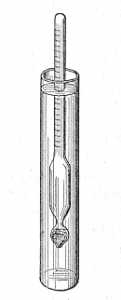
Use in Fluid Dynamics Ι lab.
A hydrometer is an instrument that measures the specific gravity (relative density) of liquids—the ratio of the density of the liquid to the density of water.
A hydrometer is usually made of glass, and consists of a cylindrical stem and a bulb weighted with mercury or lead shot to make it float upright. The liquid to test is poured into a tall container, often a graduated cylinder, and the hydrometer is gently lowered into the liquid until it floats freely. The point at which the surface of the liquid touches the stem of the hydrometer correlates to specific gravity. Hydrometers usually contain a scale inside the stem, so that the person using it can read specific gravity. A variety of scales exist for different contexts.
The apparatus is used to measure fluid density and associated quantities is the hydrometer. One can have a simple hydrometer if one take a glass tube, which is open on one side and closed at the other. Place this tube in liquid and add solid charges therein so as to float vertically.
The tube is first immersed in water and measured the level of immersion (or the submerged pipe) and then immersed in the liquid, which we want to measure the density, whereby due to the difference in densities the length of the dip tube is changed. The weights of the liquid displaced/overflown in both cases is equal to the total weight of the tube (due to the buoyancy).
The ratio of immersion length of the tube gives a relative density.
If the tube has fixed metal ballast in the bottom and is rated by dipping first in water and then in various fluids, a hydrometer can measure directly the specific gravity or relative density, or even from straight density or specific weight.
The experimental procedure for the measurement of the density is as follows
(A) Students plunging simple hydrometer first in the water and note the submerged length of the tube, and then repeat this immersion in other liquid filling the respective lengths.
(B) Students immerse the hydrometer graduated first in the water to check if the reading is 1000 and after plunging in other liquids, as before, recording now directly the relative density of each liquid.
